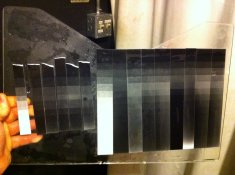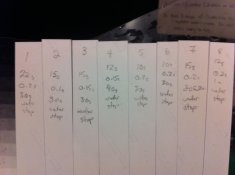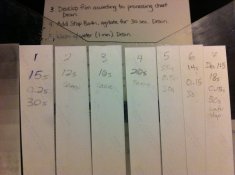The Process Analyzed
I went to the darkroom this afternoon and put some time into getting a better idea of what's going on with the reversal process, and how to try and optimize the results. For this round of tests I essentially tried to replicate the conditions that have worked in the past for me in my bathroom, and intend to further experiment in a controllable fashion rather than just guessing and checking.

This is what I came up with today. Developer was Ilford Multigrade at 1:3 dilution. Paper was some old Kodak Multigrade RC II. I set up the enlarger without filters, using a 50mm f2.8 projection lens (for speed and the size of the projected circle). The picture above shows all the stuff I exposed, first a test for max black, then the smaller strips on which I tried a nine stop exposure range. The larger strips were a dialed-in five stop exposure range in 1/3 stop increments.
For this test I began quantifying my exposure in lux-seconds to have a universal unit of comparison for the different exposure intensities between the much slower and smaller intensities which create the negative image, and the short intense exposure which induces the tone reversal.


A close-up of my results, and the development information for the big strips. As you can see, the process is sensitive to changes in pre-flash development and flash duration/intensity. My feeling is that a slightly lower developer concentration might provide better overall contrast range compared to the results I achieved today. Also, I'm curious about what, if any, effect a shorter and brighter (but same lux-second) reversing flash would have.
I can post my complete exposure data if anyone is interested, but it will likely be quite different for other paper/developer combinations. My estimations of about 0.2s flashes for the self-portraits I posted earlier in the thread seemed to produce the best results today (I calibrated the enlarger to match the measured brightness of the light at counter-top distance). Maximum black on the test strip, both negative and reversed, was achieved at ~32 ls exposure, minimum reversed density (2 stops less than max negative black) at ~ 10ls, and max reversed density (starting 1.67 stops than min rev density) at 3.2 ls and less. The reversing exposure was 64 ls for the nominal 0.2s exposure at a measured 7 EV, twice the amount of light to produce max black.
Thoughts? Comments? Criticisms?
edit: looking carefully, as I hadn't yet today--I struggled to get these tests finished with a migraine coming on, which I've only now come clear of--test strips 4 and 7 have a reasonably large difference in development and exposure times, producing very comparable and good results. As with my earlier feeling, this procedure does have a fairly wide sweet spot.










